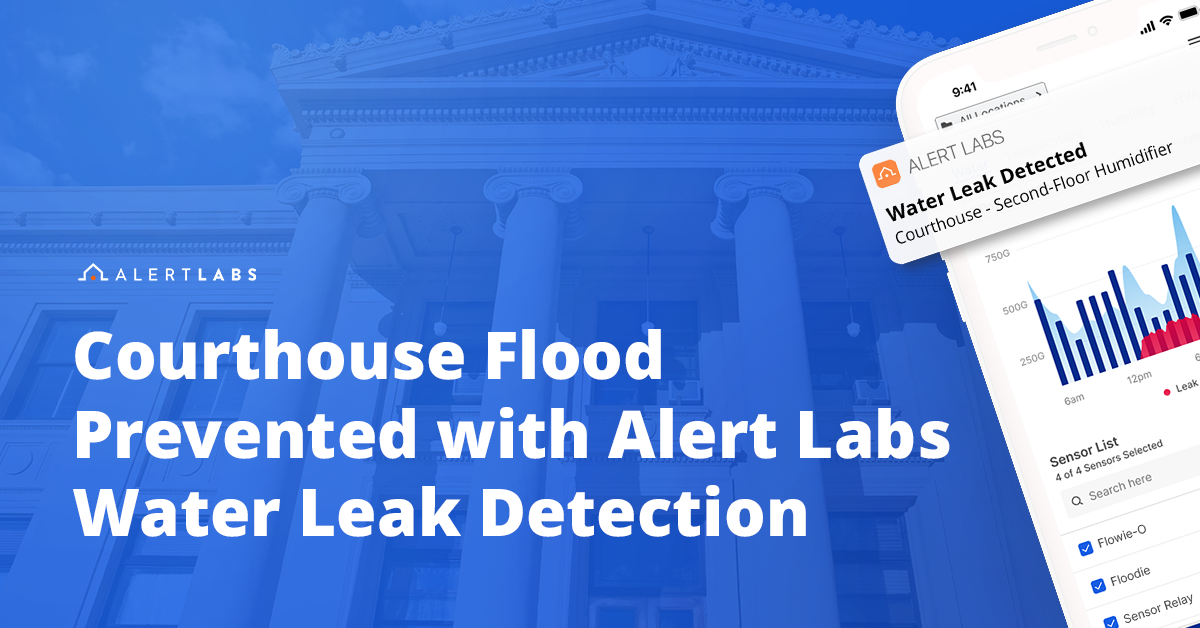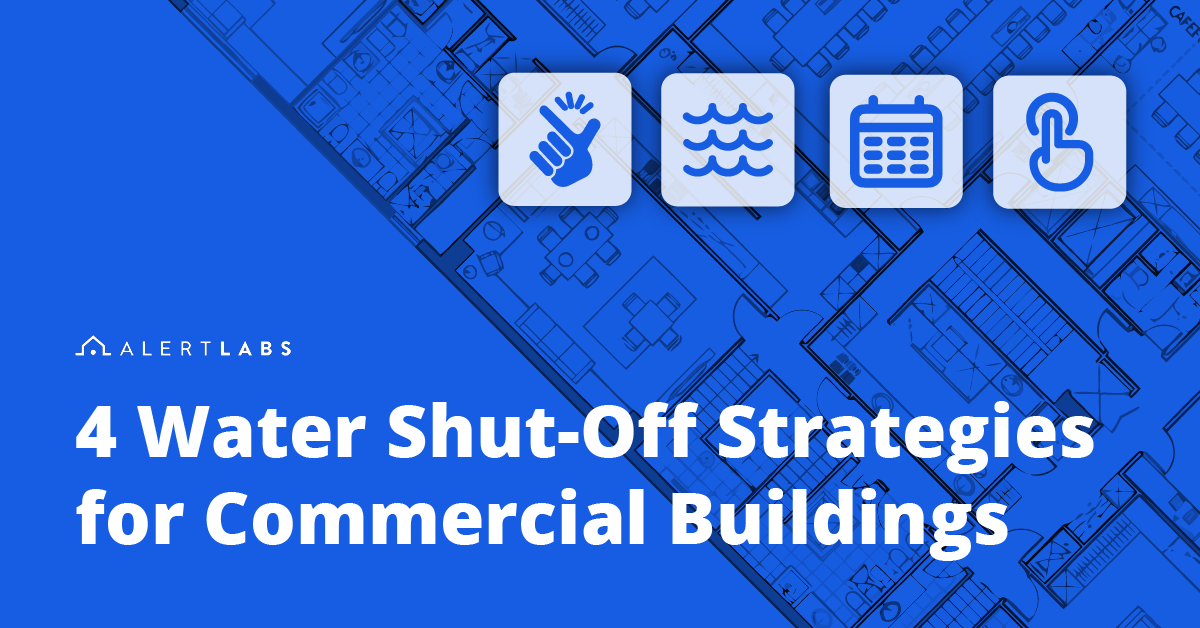Smart Water Shut-Off Valves For Commercial Buildings: A Short Guide

Water damage. Two simple words that strike fear in the heart of any commercial facility manager—and for good reason. Water damage is a leading cause of commercial real estate claims accounting for hundreds of millions of dollars in repairs each year, not to mention the cost of business interruptions and the negative health consequences from mold exposure. And water damage risk isn’t limited to just one sector. It cuts across all industries and asset classes: from apartments to warehouses.
Traditional approaches to water shut-off
One of the most effective ways to stop water damage fast is to cut off water flow. When there’s no water, there can’t be any damage. In the past, the only way to do that was to be onsite and either turn a water valve off or push a button on a costly and hardwired building automation system (BAS).
The main disadvantages with these approaches are that they are slow, can’t be retrofitted—in the case of BAS—and they require maintenance teams to be scheduled round the clock to be onsite. The decision to shut off the water is also made only after a leak is noticed or reported to maintenance teams.
So, it’s no wonder that insurance companies, property developers, construction site supervisors, and facility managers are looking for ways that technology can help mitigate the problem of water damage risk. The best solution is also the fastest way to respond to water leaks: water valves that can be shut off remotely, automatically, or on a schedule.
Remote water shut-off
Remote water shut-off is the ability to open and close water valves from anywhere, generally through a desktop or mobile app.
Remote shut-off is possible thanks to advancements in wireless communications, IoT smart sensors, and AI–powered water intelligence platforms. With a smartphone, a facility manager can stop water flow without needing to be on the same floor as the shut-off valve or even onsite for that matter.

Every second counts when it comes to mitigating water damage. Improving response time by as little as 15 minutes—or the time it takes to get from the top of a luxury condo tower to the basement where a shut-off valve might be located—could mean the difference between a mop and bucket cleanup and a six- or seven-digit water damage insurance claim.
Remotely shut-off water based on high water use data
Some water leak detection systems allow teams to view minute-by-minute water use throughout the building or across entire portfolios. The most sophisticated platforms include AI-powered water use pattern recognition. When water consumption deviates from what is considered normal use for the property, as determined by proprietary algorithms, customers receive high water use or leak alerts on their phones. These automated water use analysis and alerting systems work non-stop and without the need for visual confirmation of leaks before deciding to turn off the water.
In some cases, the decision to turn off water can be automated. In fact, a large healthcare facility is saving over $1 million with shut-off valves installed beside pressure breaker valves. This hospital success story features another innovation in water damage mitigation: the ability to shut-off water automatically.
Automatic water shut-off
Automatic water shut-off is part of a complete leak detection system. In this type of solution, a small device such as a flood puck is used to detect water. When it senses water where it shouldn't be, it automatically tells the shut-off valve to close. This stops water flow automatically and prevents damage.

Building management professionals can set up various control zones throughout buildings. When a leak is detected on a single unit within an office tower, the water supply to only that unit is shut off, for example.
While automatic shut-off responds to leaks as they happen, there are many cases where preventing unnecessary water flow in the first place can reduce risk even further.
Scheduled water shut-off
Scheduled water shut-off allows building management teams to automate when water is supplied to different areas of a property. With this approach, water valves can be programmed to open and close at specific times of day or days of the week, based on the unique needs of the building or site. For example, water can be set to turn off automatically after business hours, on weekends, or during periods when a facility is vacant.
Schedule water shut-off to protect properties after hours
This approach is especially useful for properties that are empty at certain times, such as construction sites, schools during breaks, retail branches that close overnight, or event spaces between bookings. By turning water off when it is not needed, building teams remove the risk of leaks, flooding, and wasted water during unoccupied periods.

Automating water schedules also streamlines building operations. Facility managers and construction supervisors no longer need to rely on manual shut-off procedures at the end of the day, reducing the risk of human error and saving valuable time. In addition, these systems can be integrated with alerting platforms, so teams are notified when water is turned on or off according to the set schedule.
Ultimately, this level of control gives property professionals greater peace of mind. By automating routine shut-off and turn-on times, buildings can be protected from unnecessary water exposure, operational disruptions are minimized, and the risk of costly water damage is significantly lowered.
To learn how pre-occupied to fully occupied buildings are using water leak detection systems, see article: Detect Water Leaks And Damage At Buildings Under Construction.
Water shut-off valve sizes
The best providers of water shut-off valves offer a wide range of sizes: from the ¾” valves commonly found in the units inside multi-family buildings like condos or apartments up to the 6” valves which are commonly installed on main water supplies for commercial buildings.

Matching the water shut-off solution to each building’s unique water damage risk profile is a key part of every water damage prevention strategy. Other factors such as whether or not the valve is battery or wall-powered and the communication network it runs on should also be considered.
Battery versus Plug-in water shut-off valves
For smaller valve sizes, a battery-powered water shut-off valve allows for greater portability and ease of installation because there’s no need for an electrical outlet to be installed nearby. For larger valves that require a higher amount of torque, a wall-powered solution is necessary. it's advisable to consult with a building engineer to determine the appropriate style and placement of water shut-off valves in your building. Another factor to consider is network connection.
WiFi versus Cellular communication network
For a water shut-off solution to be truly reliable it needs a dependable network connection. The most reliable networks are ones that don’t rely on a building’s WiFi—which is more prone to disconnect due to user error or power failure. When choosing a shut-off solution, cellular is the more secure network connection option.
It’s advisable to consult with your insurance provider, but in general, insurance companies prefer always-on, cellular-connected shut-off valves.
In conclusion, the era of reactive water damage management is over. With the advent of remote and automatic water shut-off technologies, facility managers and sustainability directors now have unparalleled control over their water systems. The integration of intelligent water management solutions not only mitigates the risk of water damage but also offers substantial financial benefits and operational efficiencies.




